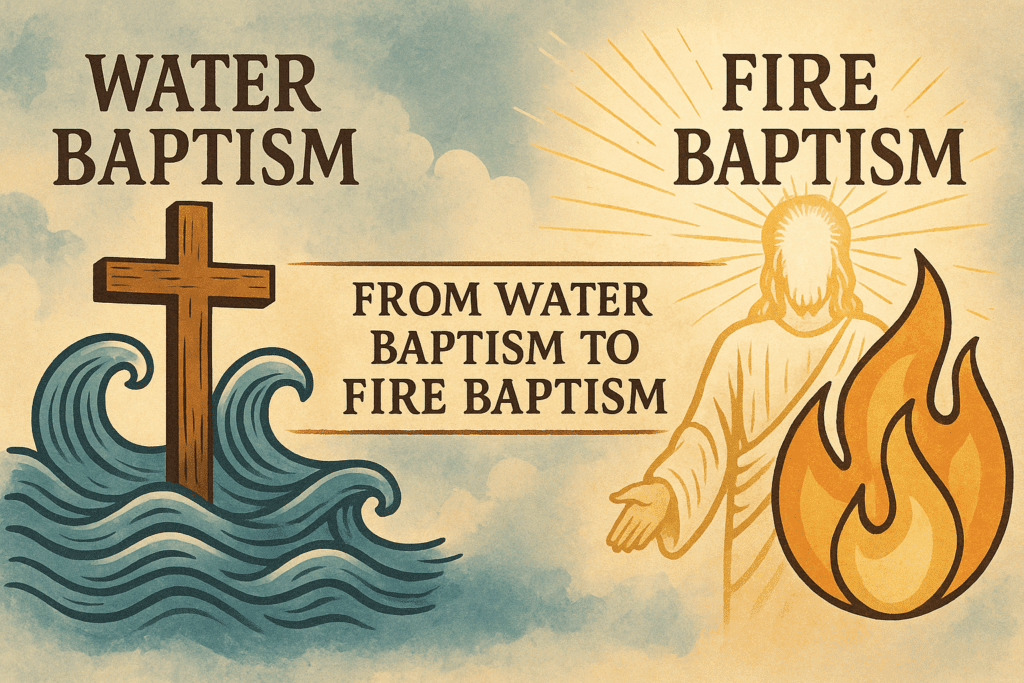Introduction: Water Baptism to Fire Baptism
This article explores the meaning of water baptism as the starting point of spiritual transformation, drawing from the Bible’s full arc—from Genesis to Jesus to the end of the age.
Baptism Means Embracing the Whole Word of God
Water baptism is not just a symbol of personal repentance. It is a public declaration that a person is ready to receive the whole Word of God—Old and New Testaments alike. Too many treat parts of the Bible as obsolete, but baptism calls us to embrace all of God’s counsel.
“Man shall not live by bread alone, but by every word that proceeds from the mouth of God.” (Matthew 4:4; see also Deuteronomy 8:3)
This is not a symbolic dabble in religion—it’s a full surrender to divine truth. When someone is water baptized, they are spiritually affirming that they will consume all of God’s Word, allowing it to prosper their soul and renew their mind (see Joshua 1:8, Romans 12:2). The old man dies—meaning the surrender of our natural selves—and a new man arises through the Spirit. This is the inward transformation described in 2 Corinthians 5:17: “If anyone is in Christ, he is a new creation; the old has gone, the new is here.”
From the Waters of Death to the Fire of Purification
In none of these powerful stories does God wait for human righteousness to create a new covenant. Every transition—through the water, by the Spirit, toward the promise—is initiated by God’s grace. Just like the flood, the Red Sea, and the Jordan crossings, the renewal is not earned, but given. Grace is not a New Testament concept; it is God’s eternal way of working with humanity. Noah, Moses, and Joshua — and the blessings that followed were rooted in that relationship, not performance. As Jesus says in the Sermon on the Mount, it’s not about calling on His name only—it’s about knowing Him (Matthew 7:21–23).
In every case, there is still a requirement: to receive the gift. Noah had to enter the ark. The Israelites had to step into the sea. The priests had to carry the Ark into the Jordan. Even Jesus submitted to baptism (for the sake of fulfilling prophecy). Salvation is offered by grace, but it must be accepted in faith.
Throughout Scripture, the movement from water to Spirit to fire reveals a consistent pattern in how God transforms His people.
- Creation: God begins over the waters, bringing life (Genesis 1:2)
- Noah: The floodwaters purge the earth, followed by covenant (Genesis 8–9)
- Red Sea: A passage through water marks death to slavery, birth into covenant (Exodus 14)
- Jordan River: The old generation dies in the wilderness, the new enters through water (Joshua 3)—representing the faithful generation that replaces the one that died in the wilderness and now enters the Promised Land
- Jesus’ Baptism: Water + Spirit = the beginning of His public ministry (Matthew 3)—symbolizing that He is the true bridge between the fallen world and Heaven itself, the fulfillment of every crossing before Him
In each case, water marks the end of the old and the start of the new.
But the story doesn’t stop there.
“He will baptize you with the Holy Spirit and with fire.” (Matthew 3:11)
The Fire is Just as Real as the Water
John the Baptist wasn’t just being poetic. He was prophesying what would come:
- Spiritual fire: sanctifying believers (Acts 2, Malachi 3:2–3, Zechariah 13:9)
- Final judgment fire: purging the earth like the flood once did (2 Peter 3:7, 10–13)
Just as the flood was both literal and spiritual, so is the fire.
- The Holy Spirit purifies us now.
- Final judgment will come by fire—not water—at the end of the age.
“The present heavens and earth are reserved for fire…” (2 Peter 3:7)
Jesus’ death was sealed with water and blood flowing from His side (John 19:34), and His resurrection power was released with the Spirit and fire. Baptism with water is just the beginning. The fire is coming.
The Holy Spirit Is Always Present in God’s Baptisms
At creation, He hovers over the water.
At the flood, God sends a ruach—a wind, or Spirit—to dry the earth (Genesis 8:1).
At the Red Sea and the Jordan, miraculous partings come with His hand.
At Jesus’ baptism, the Spirit descends like a dove.
“Unless one is born of water and the Spirit, he cannot enter the Kingdom of God.” (John 3:5)
The pattern is consistent. Water symbolizes death and covenant entry, but it is the Holy Spirit who transforms, purifies, and ultimately finishes what was started.
The Baptism That Truly Matters
Baptism is not just a ritual. It is a prophetic reenactment of the gospel:
- Dying to sin (water)
- Being raised in new life (Spirit)
- Being refined for glory (fire)
“This water symbolizes baptism that now saves you also—not the removal of dirt from the body but the pledge of a clear conscience toward God.” (1 Peter 3:21)
When someone chooses baptism, they are saying:
“I will embrace the whole Word. I will die to the old. I will receive the Spirit. I will be ready when the fire comes.”
Conclusion: From Water Baptism to Fire Baptism: From Genesis to Revelation the Word is our Food.
Water baptism, as seen throughout Scripture, affirms the enduring authority and applicability of the entire Bible. From Genesis to Revelation, the symbolic meaning and transformative power of water baptism remind believers that God’s whole Word is alive and relevant. It is not merely a New Testament ordinance—it is a visible sign of embracing the full covenant truth of God’s grace, revealed through every age.
For more biblical insights, visit our article on The Sermon on the Mount to see how Jesus fulfills the heart of every covenant in Scripture.
For additional study and cross-references, visit BibleHub’s Baptism Concordance.
